Unit 3 Laws Of Motion Chapter 1 Newton Law Of Motion Multiple Choice Questions And Answers
Question 1. A closed container filled with gas is moving horizontally with some acceleration. The pressure of the gas in the container (neglecting gravitational pull) is
- Same throughout
- Comparatively less at the front
- Comparatively less at the back wall
- Comparatively less in the upper part
Answer: 2. Comparatively less at the front
Question 2. Two masses, m and 2 m are connected by a string that passes over a frictionless pulley. When the mass 2m is released, the acceleration of the mass m upwards will be
- g/3
- g/2
- g
- 2g
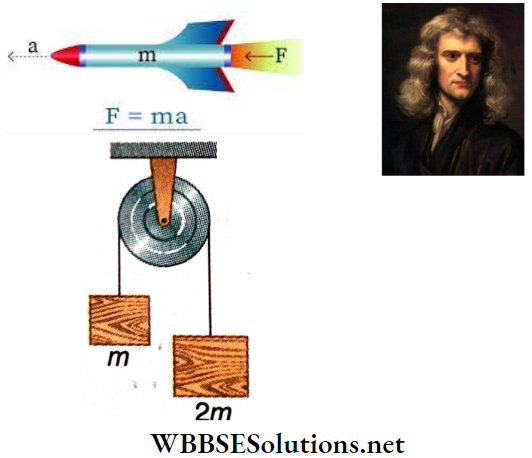
Answer: 1. g/3
Question 3. The masses of blocks A and B are 2 kg and 3 kg respectively. The blocks are kept at rest on a frictionless horizontal table. When a horizontal force of 10 N is applied to A, the force applied on B by A will be
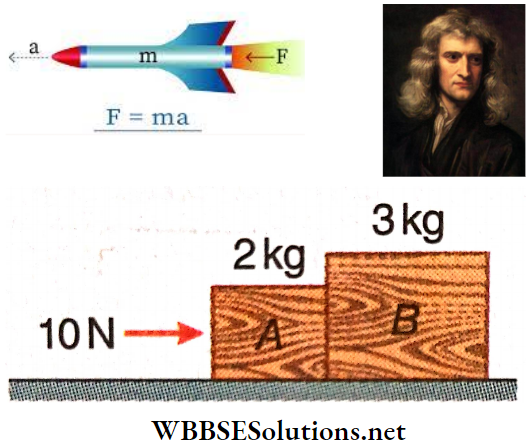
- 4N
- 6N
- 8N
- 10N
Answer: 2. 6N
Question 4. A person of mass M is at a height h from a floor in a place free from gravitational force. The person throws a ball of mass m, downward with a velocity u. Distance of the person from the floor, when the ball touches the floor, will be
- \(h\left(1+\frac{m}{M}\right)\)
- \(h\left(2-\frac{m}{M}\right)\)
- 2h
- \(5 h\left(4+\frac{m}{2 M}\right)\)
Answer: 1. \(h\left(1+\frac{m}{M}\right)\)
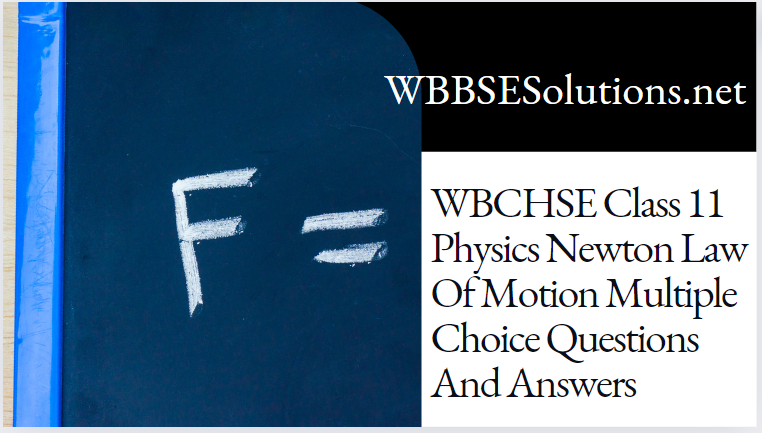
Question 5. A block is released from the top of an inclined plane of inclination θ and height h. The time required to reach the foot of the inclined plane is
- \(\sqrt{\frac{2 h}{g}}\)
- \(\sin \theta \sqrt{\frac{2 h}{g}}\)
- \(\frac{1}{\sin \theta} \sqrt{\frac{2 h}{g}}\)
- \(\frac{1}{\cos \theta} \sqrt{\frac{2 h}{g}}\)
Answer: 3. \(\frac{1}{\sin \theta} \sqrt{\frac{2 h}{g}}\)
Question 6. A plumb line is hanging from the roof of a car. When the car moves with acceleration a, the angle that the plumb line makes with the vertical is
- \(\tan ^{-1} \frac{a}{g}\)
- \(\tan ^{-1} \underset{a}{g}\)
- \(\cos ^{-1} \frac{a}{g}\)
- \(\sin ^{-1} \frac{g}{a}\)
Answer: 1. \(\tan ^{-1} \frac{a}{g}\)
Question 7. Consider an elevator moving downwards with an acceleration a, the force exerted by a passenger of mass m in the floor of the elevator is
- ma
- ma-mg
- mg- ma
- mg+ ma
Answer: 3. mg- ma
Question 8. A monkey is descending from the branch of a tree with a constant acceleration. If the breaking strength of the branch is 75% of the weight of the monkey, the minimum acceleration with which the monkey can slide down without breaking the branch is
- g
- 3g/4
- g/2
- g/4
Answer: 4. g/4
Question 9. A car moving with a speed of 50 km/hr can be stopped by brakes, over a distance of 6 m. If the same car is moving at a speed of 100 km/hr, the stopping distance is
- 12 m
- 18 m
- 6 m
- 24 m
Answer: 4. 24 m
Question 10. The x and y coordinates of a particle at any time t are given by x = 7t + 14t² and y = 5t, where x and y are in meters and t is in seconds. The acceleration of the particle at t = 5 s is
- Zero
- 8 m · s-2
- 20 m · s-2
- 40 m · s-2
Answer: 2. 8 m · s-2
Question 11. A ball of mass 0.5 kg is moving with a velocity v of 2 m · s-1. It is subjected to a force of xN in 2 s. Because of this force, the ball moves with a velocity of 3 m · s-2. The value of x is
- 5 N
- 8.25 N
- 0.25 N
- 1N
Answer: 3. 0.25 N
Question 12. A force F1 of 500 N is required to push a car of mass 1000 kg slowly at constant speed on a level road. If a force F2 of 1000 N is applied, the acceleration of the car will be
- Zero
- 1.5 m · s-2
- 1 m · s-2
- 0.5 m · s-2
Answer: 4. 0.5 m · s-2
Question 13. A cricket ball of mass 0.5 kg, moving at 30 m · s-1, hits a bat perpendicularly and rebounds with a velocity of 20 m · s-1. The impulse of the force exerted by the ball on the bat is
- 0.5 N · s
- 1.0 N · s
- 25 N · s
- 50 N · s
Answer: 3. 25 N · s
Question 14. A rocket consumes fuel at the rate of 100 kg · s-1. Gas ejects out of it with a velocity of 5 x 10 m · s-1. If the gravitational pull is neglected, the impulsive force experienced by the rocket is
- 5 X10²N
- 5 X 104N
- 5 X106N
- 5 X108N
Answer: 3. 5X106N
Question 15. A ball of mass m is bowled at a velocity v to a batsman. The batsman hits the ball, deflecting its direction by an angle θ, without changing the magnitude of velocity. The impulse of the ball is
- mv cosθ
- mv sinθ
- \(2 m v \cos ^2 \frac{\theta}{2}\)
- \(2 m v \cos \frac{\theta}{2}\)
Answer: 4. \(2 m v \cos \frac{\theta}{2}\)
Question 16. A bird sits on a stretched telegraph wire. The increase in tension in the wire is
- Equal to the weight of the bird
- More than the bird’s weight
- Less than the bird’s weight
- Zero
Answer: 2. More than the bird’s weight
Question 17. A block of mass 10 kg is suspended by three strings as shown. The tension T2 is
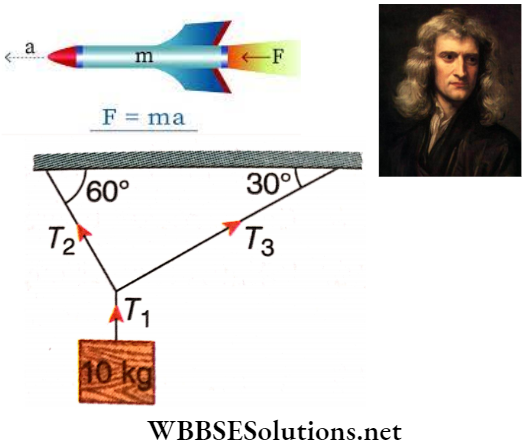
- 100 N
- \(\frac{100}{\sqrt{3}} \mathrm{~N}\)
- √3x 100 N
- 50√3N
Answer: 4. 50√3N
Question 18. Two bodies of masses 5 kg and 3 kg respectively are connected to two ends of a light string passing over a horizontal frictionless pulley. The tension in the string is (g = 9.8 m/s²)
- 60 N
- 36.75 N
- 73.50 N
- 18 N
Answer: 2. 36.75 N
Question 19. If the elevator is moving upwards with a constant acceleration of 1 m/s², the tension in the string connected to block A of mass 6 kg would be (g = 10 m/s²)
- 60 N
- 66 N
- 54 N
- 42 N
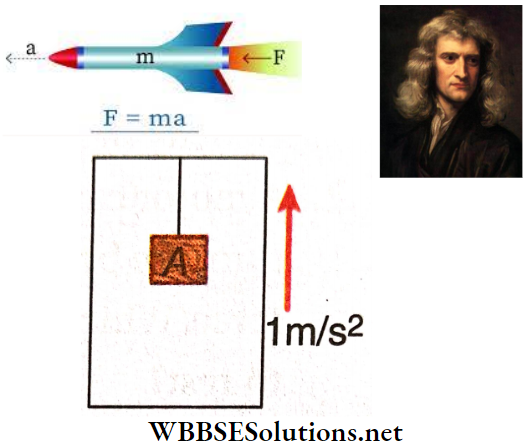
Answer: 2. 66 N
Question 20. A man of weight w is in a lift that is moving up with an acceleration a. If acceleration due to gravity is g, the apparent weight of the man will be
- \(w\left(1+\frac{a}{g}\right)\)
- \(w\left(1-\frac{a}{g}\right)\)
- w
- Zero
Answer: 1. \(w\left(1+\frac{a}{g}\right)\)
Question 21. A thief steals a treasure box of weight w. He then jumps off a wall of height h with the box on his head. The weight felt on his head before he touches the ground is
- 2 w
- w
- \(\frac{w}{2}\)
- Zero
Answer: 4. Zero
Question 22. The working principle of a jet engine is based on the principle of
- Conservation of mass
- Conservation of energy
- Conservation of linear momentum
- Conservation of angular momentum
Answer: 3. Conservation of linear momentum
Question 23. A free particle of mass m was in motion along the x-axis on a horizontal x-y plane kept at a fixed height above the earth. On sudden explosion, the particle broke up into two pieces of masses \(\frac{m}{4}\) and \(\frac{3m}{4}\). After an interval of time, the position of the smaller fragment along the y-axis became y = 15 cm. At that moment, the position of the larger piece was
- y = -5 cm
- y = + 20 cm
- y = + 5 cm
- y = -20 cm
Answer: 1. y = -5 cm
Question 24. A truck, carrying sand, moves with uniform velocity u on a smooth horizontal road. If Δm mass of sand falls in time Δt from the truck, then to maintain the speed u, the truck needs a force
- \(\frac{\Delta m u}{\Delta t}\)
- \(\frac{\Delta m u}{2 \Delta t}\)
- \(\frac{\Delta m u^2}{\Delta t}\)
- Zero
Answer: 4. Zero
Question 25. A few lead pellets, each of mass m, fall on a horizontal plane. Each pellet touches the plane with velocity u. If n number of pellets fall per second and none renounces, applied force on the horizontal plane will be
- \(\frac{m u}{n}\)
- \(n m u\)
- \(\frac{n m}{u}\)
- \(\frac{m}{n u}\)
Answer: 2. \(n m u\)
Question 26. A boy of mass m is standing on a wooden plank, of mass M and length l, floating on water. If the boy walks over the plank at a constant velocity from one end to the other, the displacement of the plank is
- \(\frac{m l}{M}\)
- \(\frac{M l}{m}\)
- \(\frac{m l}{(M+m)}\)
- \(\frac{m l}{(M-m)}\)
Answer: 3. \(\frac{m l}{(M+m)}\)
In this type of question, more than one options are correct.
Question 27. Suppose a body that is acted on by exactly two forces is accelerated. For this situation mark out the incorrect statements.
- The body can not move with constant speed
- The velocity can never be zero
- The resultant of two forces cannot be zero
- The two forces must act in the same line
Answer:
1. The body can not move with constant speed
2. The velocity can never be zero
4. The two forces must act in the same line
Question 28. Which of the following statements can be explained by Newton’s second law of motion?
- To stop a heavy body (say truck), greater force is needed than to stop a light body (say motorcycle) in the same time if they are moving at same speed
- For a body of given mass, the greater the speed, the greater the opposing force needed to stop the body in a particular time duration
- To change the momentum of a body by given value, the force required is independent of time
- The same force acting on two different bodies for same time causes the same change in momentum for the different bodies
Answer:
1. To stop a heavy body (say truck), greater force is needed than to stop a light body (say motorcycle) in the same time if they are moving with same speed
2. For a body of given mass, the greater the speed, the greater the opposing force needed to stop the body in a particular time duration
4. The same force acting on two different bodies for the same time causes the same change in momentum for the different bodies

